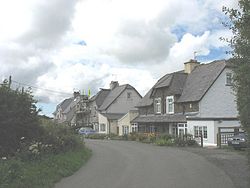Llangaffo
| Llangaffo | |
| Anglesey | |
|---|---|

| |
| Location | |
| Grid reference: | SH445685 |
| Location: | 53°11’28"N, 4°19’38"W |
| Data | |
| Postcode: | LL60 |
| Local Government | |
| Council: | Anglesey |
| Parliamentary constituency: |
Ynys Môn |
Llangaffo is a village on the Isle of Anglesey. It lies along the B4419 and B4421 roads, north of Dwyran, south of Gaerwen and northwest of Llanidan. It is named after Caffo, a 6th-century saint.
The parish church, St Caffo's Church, is named after him. A war memorial, a village hall and a primary school are also located in the village. The 1851 census recorded 138 people in the village, 75 men and boys, 63 women and maids, and a parish area of 1,590 acres.[1]
Geography

Llangaffo is a parish in the Menai Hundred of the County of Anglesey. It is 4 miles northwest of Caernarfon and 4 miles south of Llangefni. It stands close to the North Wales Coast Line, although the nearest station (Gaerwen railway station) closed in 1966.
The village is situated on a vantage hill ridge that provides vistas of pastureland and the hills of Snowdonia and the Menai Strait.[2] The mountains of Snowdonia across the strait in Caernarfonshire terminate in the west with the abrupt precipices of Yr Eifl, seen from Llangaffo.
The parish covers an extensive tract of land, of which a large portion is marshy, some part hilly, and the remainder in a fair state of cultivation. In 1790, an Act of Parliament was obtained for more effectually embanking the marshes called Malltraeth and Corsddeuga, under the provisions of which 230 acres were allotted to the several proprietors of land in this parish. The soil is in general fertile, and the lower grounds afford excellent pasturage for cattle. The surrounding scenery is varied, while the higher grounds afford vistas over the adjacent countryside. Mats are manufactured from the seaweed extracted from the marshy area.[1]
St Caffo's Church
 |
 |
St Caffo's Church was built in 1846 to replace the previous mediæval church on the site. The new building includes a number of monuments from the old church, and has a spire which is a prominent local landmark. The churchyard has part of a stone cross dating from the 9th or 10th century, and some gravestones from the 9th to 11th centuries. It is dedicated to St Caffo, a 6th-century martyr who was killed in the vicinity.
The church is still in use as part of the Church in Wales, one of four churches in a combined parish. It is a Grade II listed building, in particular because it is regarded as "a mid 19th-century rural church, consistently articulated and detailed in an Early English style".[3][4]
The lintel of the church's northern doorway consists of a tomb-stone 6 feet long, bearing a poorly-incised cross, plain and with the arms gradually widened. In the churchyard, there is a mutilated cross on a crude pedestal, now used as a sundial, on the front of which is sculptured a cross with equal limbs, each dilated at the extremity, inscribed within a circle, beneath which are two incised trefoils. The edge of the stone is ornamented with the classical fret seen on the Penmon Priory stones and cross. The carving is defaced and difficult to make out.[5] A wheel head, an early Christian monument, has also been found at the church. The lower half of the wheel is triple-beaded and of Celtic-style, the head contains arm ends in square or hammer shaped style, while the detailing on the cross arms includes raised mouldings.[6]

Grounds
Gravestones with carvings of cross are seen in the churchyard and one of them is of 7th-century vintage.[2] A war memorial in the churchyard,[7] commemorates the names of Llangaffo residents who were killed or missing in First World War and Second World War.[8]
Sights about the village
In the parish are slight remains of Bodwyr, an old house of the 16th century, now part of a farm and bed and breakfast. The primary school is Ysgol Llangaffo ("Llangaffo School"), opened in 1854,[9] and located along the main road in the heart of the village.
Archaeology
Two gold coins of the Emperor Constantine, in a good state of preservation, were found near the church, in the year 1829, and several silver and copper coins of that and other emperors have been found in the parish. [1] Small concentrations of stone have been found around Llangaffo, possibly indicating stone cutter activity that under monastic direction.[6]
Outside links
| ("Wikimedia Commons" has material about Llangaffo) |
References
- ↑ 1.0 1.1 1.2 Information on Llangaffo from GENUKI
- ↑ 2.0 2.1 "Llangaffo, Anglesey". Wales Directory. http://www.walesdirectory.co.uk/Towns_in_Wales/Llangaffo_Town.htm. Retrieved 15 August 2011.
- ↑ Cadw listing (5508) - Church of St Caffo
- ↑ "Church in Wales: Benefices". Church in Wales. http://www.churchinwales.org.uk/rb/ben.php?dosommat=detail&which=742. Retrieved 26 January 2011.
- ↑ Westwood, John Obadiah (1879). Lapidarium walliae: the early inscribed and sculptured stones of Wales (Now in the public domain. ed.). Printed at the University Press for the Cabrian Archaeological Assoc.. pp. 186–.
- ↑ 6.0 6.1 Nash-Williams, Victor Erle (1950). The early Christian monuments of Wales. Univ. of Wales press. p. 18, 57.
- ↑ "The Llangaffo War Memorial The memorial is situated". geolocation.ws. http://www.geolocation.ws/v/W/4d7c370d8786567a400096ae/the-llangaffo-war-memorial-the-memorial/en. Retrieved 16 August 2011.
- ↑ "War Memorial Llangaffo". ww2museums.com. http://www.ww2museums.com/article/19779/War-Memorial-Llangaffo.htm. Retrieved 15 August 2011.
- ↑ "http://www.llangaffo.anglesey.sch.uk/Cymraeg/ysgol_llangaffo.htm" (in Welsh). llangaffo.anglesey.sch.uk. http://www.llangaffo.anglesey.sch.uk/Cymraeg/ysgol_llangaffo.htm. Retrieved 13 August 2011.